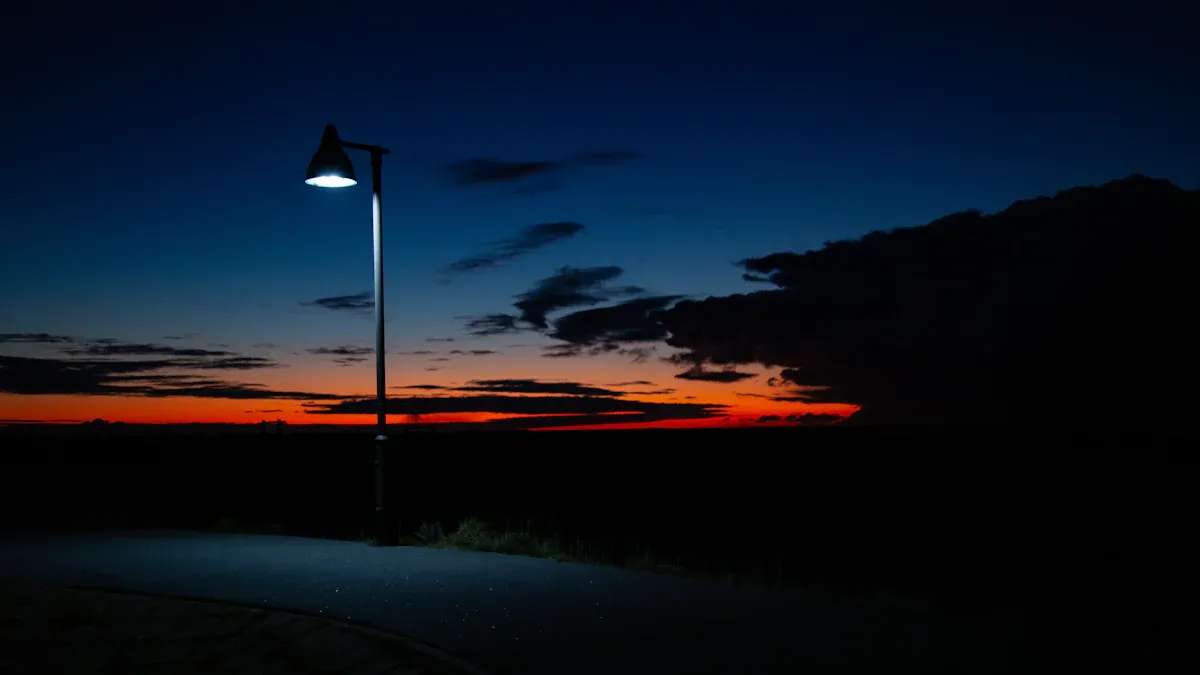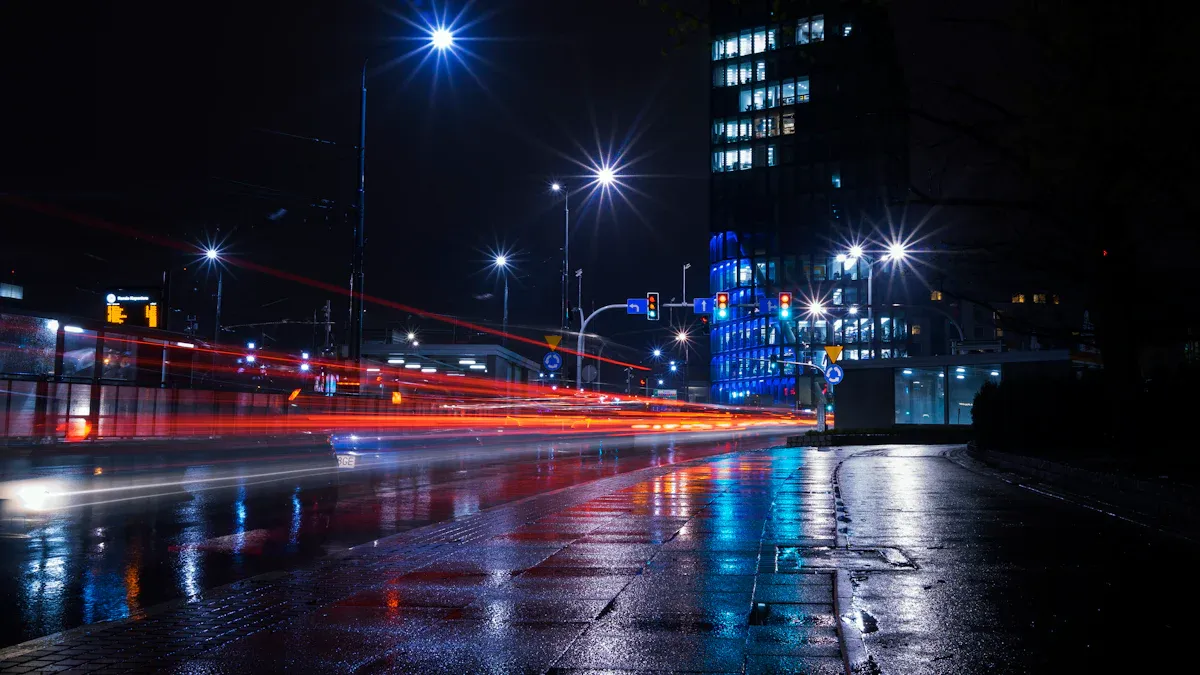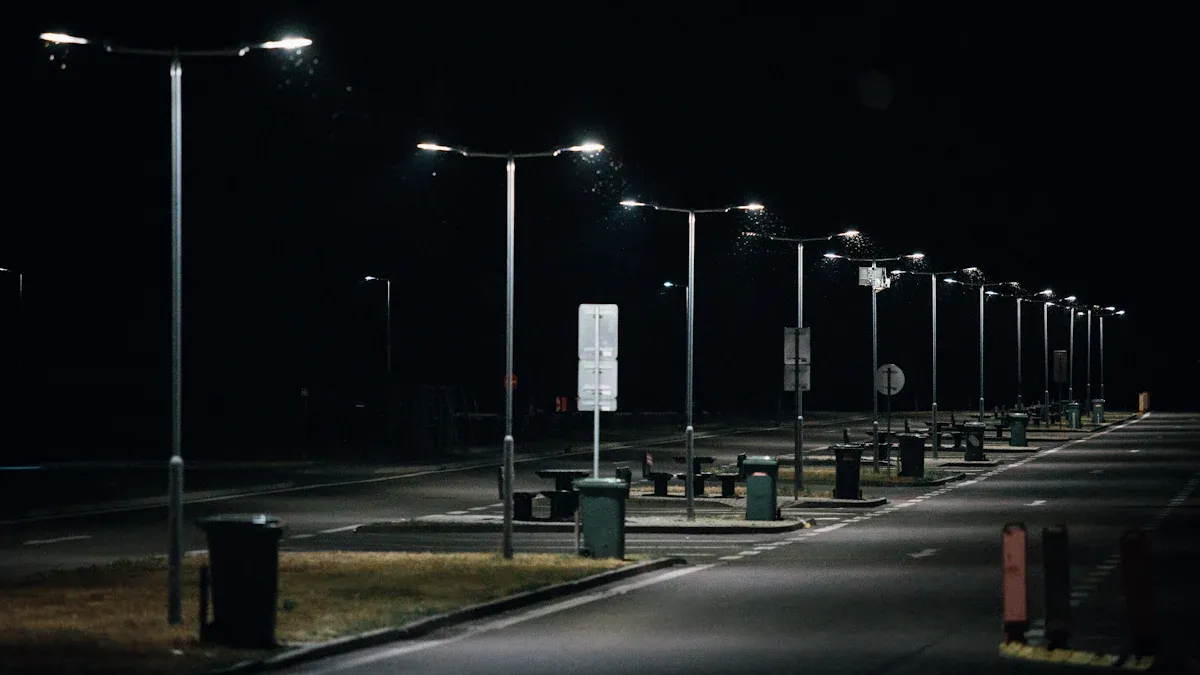The Evolution of LED Street Lighting: Trends and Technological Advancements

LED street lighting has transformed cities by saving energy and lasting longer. Switching to LED street lighting can lower a city's energy use by 70%. This helps save money and protect the environment. LED street lighting lasts over 50,000 hours, creating less waste and saving more over time. New smart systems for LED street lighting make streets safer by adjusting brightness when needed. This improves visibility and helps prevent accidents. Using LED street lighting helps cities use less energy and cut pollution. It also makes cities cleaner and smarter for the future.
Key Takeaways
Using LED streetlights can cut energy use by 70%. This saves money and helps the planet.
LED streetlights work for over 50,000 hours. This means fewer replacements and cheaper upkeep for cities.
Smart lights change brightness based on activity. This makes areas safer and uses less energy.
Solar-powered LED streetlights use sunlight instead of fuel. This helps cities rely less on non-renewable energy.
Cities can reduce carbon pollution with LED streetlights. This helps create a cleaner and greener world.
History of LED Street Lighting
Early Development of LED Technology
LED technology started with important research in the late 1900s. In 1998, scientists studied white LEDs and how semiconductors could change lighting. This was a big step toward energy-saving lights. By 2000, LED lights were sold for indoor use. They showed promise but were expensive at first. These early steps helped LEDs become a major part of lighting, including streetlights.
Adoption in Public Lighting Systems
Cities around the world now use LEDs for public lighting. LEDs save more energy than any other lighting option. This makes them perfect for city streets. In the U.S., streetlights use 30% of outdoor lighting energy. Switching to LEDs helps cities save money and energy. For example:
City | Savings Over Time | CO2 Cut Each Year (tons) |
|---|---|---|
Newton, Mass. | $3M in 20 years | 1,240 |
Los Angeles | $8M yearly | N/A |
New York City | $14M yearly | N/A |
These numbers show how LEDs help both the environment and budgets. If all U.S. cities used LEDs, they could save energy for 5.8M homes yearly.
Milestones in LED Street Lighting Evolution
LED streetlights improved thanks to many key moments in history. Early lights like Edison’s bulbs and fluorescent lamps led to modern designs. In the 2000s, LED technology became more efficient and flexible. Today, LED streetlights are long-lasting, bright, and energy-saving. They are vital for building greener cities.
Did you know? LED streetlights last over 50,000 hours. This lowers waste, cuts costs, and supports sustainability.
Trends in LED Street Lighting

Integration with Smart Lighting Systems
Smart lighting is changing how cities light streets. These systems use technology to change brightness based on activity. For example, sensors dim lights when streets are empty. When people or cars are around, lights get brighter. This saves energy and keeps streets safe.
Cities like Sheffield use smart streetlights with the DALI protocol. These systems save up to 40% more energy than old lights. They also cut greenhouse gases by 30–50%, helping the environment. Using smart lights saves money, reduces waste, and keeps the air cleaner.
Tip: Smart lights save energy and make streets safer by improving visibility.
IoT and Smart City Applications
The Internet of Things (IoT) is a big part of smart cities. IoT streetlights can check their condition and report problems. They can also collect data about the environment. Cities can control these lights to fit their needs. For example, lights can dim during quiet times or brighten in busy areas.
In many smart cities, most streetlights are connected through IoT. This saves energy and lowers costs. IoT streetlights also help with air quality checks and traffic control. Upgrading to IoT lights helps cities save money and work better.
Did you know? IoT streetlights can adjust brightness, report issues, and track environmental data. They are key to smart city technology.
Focus on Energy Efficiency and Cost Reduction
Saving energy is a main goal for LED streetlights. LEDs use much less energy than older lights. This helps cities lower costs and cut pollution. Cities using LEDs save over $6 billion yearly on electricity.
LEDs last over 50,000 hours, so they need fewer replacements. This lowers maintenance costs and saves money. Better light quality also makes streets safer and raises property values. These benefits make LEDs a smart choice for cities.
Benefit | Description |
|---|---|
Energy Cost Savings | LED streetlights save cities over $6 billion yearly by using less electricity. |
Reduced Maintenance Costs | LEDs last longer, needing fewer replacements and cutting labor costs. |
Improved Light Quality | Brighter, clearer lights reduce accidents and improve safety, boosting property values. |
By focusing on energy savings, cities can meet green goals and improve life for everyone.
Advancements in LED Street Lamp Technology

Improvements in LED Lifespan and Durability
Modern LED street lamps last longer and handle tough weather. Strong materials like anodized aluminum and stainless steel stop rust. These materials keep lamps working in extreme conditions. Weatherproof designs (IP-rated) block dust, water, and other damage. This makes them dependable for outdoor use.
Managing heat helps LEDs last longer. Good circuits lower heat and save energy. Advanced drivers keep LEDs working well over time. New smart controls and better materials make LEDs even stronger and longer-lasting.
Note: LED street lamps last over 50,000 hours. This means fewer replacements and lower maintenance costs.
Enhanced Brightness and Light Quality
LED street lamps are brighter and clearer than older lights. They spread light evenly, removing dark spots on roads and sidewalks. This improves safety for walkers and drivers.
LEDs can change color temperature for different places. Warm tones feel cozy in neighborhoods. Cool tones work better on busy streets. Cities can adjust lighting to fit their needs.
Studies show LEDs improve safety by making streets brighter. A report called "The Indispensable Role of Post-Top LED Street Lights in Enhancing Public Safety" says LEDs lower accidents. Clearer light also helps stop crime, keeping areas safer.
Tip: Switching to LED street lamps makes streets brighter and cities look better.
Reduction in Environmental Impact
LED street lamps are better for the environment. They use 75% less energy than old bulbs. This lowers carbon emissions and saves electricity.
Smart LED lamps can dim when streets are empty. They brighten when needed, saving more energy. Solar-powered LEDs use sunlight, making them even greener. These features help cities stay eco-friendly.
A study called "The Environmental Benefits of Post-Top LED Street Lights" shows how LEDs save energy and cut waste. Cities using LEDs can meet green goals and save money.
Did you know? Switching to LED street lamps saves enough energy to power millions of homes each year.
Sustainability and LED Street Lighting
Eco-Friendly Manufacturing and Disposal Practices
LED streetlights help the planet by using eco-friendly methods. Many are made with sustainable materials and work with renewable energy. These materials cause less harm to nature and support green cities. LEDs also reduce light pollution, which helps animals and keeps nature balanced.
LEDs last longer than old lights, so they need fewer replacements. This creates less waste over time. Recycling LEDs stops pollution and saves useful materials. Cities now hold events to collect old electronics, and stores offer recycling programs for used LEDs. Joining these programs helps the environment and reduces waste.
Tip: Using LED streetlights saves energy and supports green practices for a better future.
Solar-Powered LED Streetlights
Solar-powered LED streetlights are changing how we light streets. They mix LED technology with solar power, cutting the need for non-renewable energy. These lights store sunlight during the day and use it at night. They are perfect for sunny areas and save energy.
Studies show more people are turning to solar power to cut carbon emissions. Governments are offering rewards to encourage solar-powered LED use. These lights make streets safer and help cities grow sustainably by using clean energy.
Did you know? Solar-powered LED streetlights don’t need the power grid. They work well in remote or disaster-hit areas.
Contribution to Carbon Emission Reduction
LED streetlights help lower carbon emissions in big ways. They use 50% to 75% less energy than older lights. This means fewer greenhouse gases are released. For example, adding cooling tech to LEDs could save 1.9 TWh of energy yearly in the U.S. This would cut CO2 emissions by 1.3 million metric tons, about 0.03% of the U.S.’s total in 2018.
Switching to energy-saving LEDs helps cities shrink their carbon footprint. These changes not only protect the planet but also create a cleaner future.
Note: Choosing energy-saving lights like LEDs helps build a greener world for everyone.
Challenges in LED Street Lighting
Managing High Initial Costs
Switching to LED lights can seem costly at first. Installing LED systems costs more than older lights. But, they save money over time. LEDs last longer and use less energy. This lowers electricity and repair costs. Many cities find ways to handle these upfront costs. Governments offer grants or rewards to help with the switch. Cities can also team up with private companies to share costs. These methods make it easier to use LEDs. They improve safety and cut energy use.
Fixing Technical Problems
Technical issues can slow down LED streetlight upgrades. Some cities have trouble matching LEDs with old systems. Others find smart controls hard to manage. Energy service companies can help solve these problems. A study shows these companies give cities tools and advice. They help with both tech and money challenges. Governments can also make rules to support LED use. Fixing these problems helps cities save energy and stay safe.
Reducing Glare and Light Pollution
LED streetlights make streets brighter but can cause glare. Poor designs may also lead to light pollution. These problems can be fixed with simple steps. Use lower color temperatures, like 3,000 kelvin, in neighborhoods. Shields can aim light downward to stop skyglow. Dimming features protect animals like sea turtles and birds. Amber-colored LEDs are another good choice. They give off less blue light, which is safer for wildlife.
Method | Description |
|---|---|
Lower Color Temperatures | Use LEDs with 3,000 kelvin or less in neighborhoods. |
Dimming | Helps protect animals like sea turtles and migrating birds. |
Shields | Aims light downward to reduce glare and skyglow. |
Amber-colored LEDs | Safer for wildlife because they emit less blue light. |
By using these ideas, cities can make streets safer and protect nature.
Future of LED Street Lighting
New Ideas in LED Technology
The future of LED street lighting is full of exciting changes. Adaptive lights are becoming popular. These lights change brightness based on real-time needs. This keeps streets bright and saves energy. Smart systems are also improving. For example, cities like Copenhagen use LED streetlights that adjust to traffic and weather. This makes streets safer and uses less energy.
By 2025, new energy rules will push cities to use better LED technologies. Fast-growing cities, especially in developing countries, will need more smart lights. These changes show how LEDs help make cities safer and greener.
Did you know? Los Angeles switched 200,000 streetlights to LEDs, cutting energy use by 63%.
Bigger Role in City Growth
LED street lighting is key to modern city growth. Cities are replacing old lights with energy-saving LEDs. This helps cut energy use and lower carbon emissions. Governments also support this switch with green rewards. The streetlight market, worth $13.5 billion in 2024, shows the demand for eco-friendly lights.
Good lighting also makes cities safer. Studies say smart LED streetlights can cut deadly car crashes by 50%. By using these lights, cities save energy and create safer places to live.
Tip: Using LED streetlights helps the planet and keeps people safe.
More Energy Savings Possible
Switching to LED streetlights saves a lot of energy. Public lights use up to 40% of city electricity. LEDs use 70% less power than old lights. This lowers costs and cuts pollution. For example, Cambodia replaced 12,000 streetlights with LEDs, saving 559 tons of CO2 each year.
Today, about 25% of streetlights worldwide are LEDs. There are 326 million streetlights globally, and this number will grow. As more cities use LEDs, energy savings and eco-friendly benefits will increase.
Fact Type | Details |
|---|---|
Total Streetlights | 326 million now, expected to pass 361 million by 2030. |
Energy Savings | LEDs use 70% less energy than older lights. |
CO2 Reduction Example | Cambodia saved 559 tons of CO2 yearly by switching to LEDs. |
Note: Switching to LED streetlights helps cities save energy and protect the planet.
The story of LED street lighting shows how it changes cities. New LED technology saves energy, cuts costs, and helps cities grow sustainably. Smart systems now work with other city tools, making everything more connected. Better sensors and controls make lights adjust easily. More countries are using LEDs because of government support. These changes show that LED streetlights will help create greener and smarter cities. By using this technology, you help build a cleaner and brighter future.
Key Aspect | Description |
|---|---|
Growth of Connected City Systems | Smart streetlights will improve cities by linking with other smart tools. |
Better Sensors and Controls | New ideas will help collect data and make lights adjust better. |
Worldwide Use | More countries will use LEDs as governments support the switch. |
FAQ
1. Why should cities use LED streetlights?
LED streetlights save energy and money. They last longer and make streets safer. They also cut pollution and help cities stay eco-friendly.
2. Are LED streetlights costly to install?
LEDs cost more to set up than old lights. But they save money later by using less energy and needing fewer repairs. Governments often give money or rewards to help with costs.
3. How do smart LED streetlights work?
Smart LEDs have sensors to change brightness. They dim when no one is around and brighten when needed. This saves energy and keeps streets safe.
4. Do LED streetlights hurt animals?
Badly made LEDs can bother animals. Using warm-colored LEDs and shields helps protect them. Amber LEDs are better for birds and sea turtles because they have less blue light.
5. Can solar-powered LED streetlights work on cloudy days?
Yes, solar LEDs store sunlight even on cloudy days. Strong batteries let them shine at night. They work well in places with weak power supplies.
See Also
Modern LED Street Lights: Benefits of Efficiency and Longevity
Enhancing Safety with Efficient LED Highway Lighting Solutions
The Evolution and Technology Behind General Electric LED Bulbs
A Comprehensive Overview of Street Light Bulb Types and Uses

